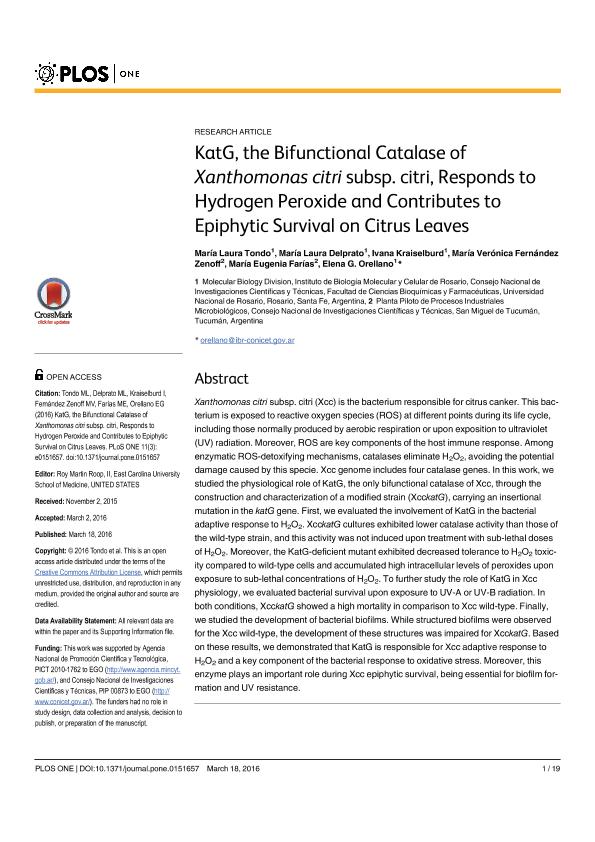Mostrar el registro sencillo del ítem
dc.contributor.author
Tondo, Maria Laura

dc.contributor.author
Delprato, María Laura

dc.contributor.author
Kraiselburd, Ivana

dc.contributor.author
Fernandez Zenoff, Maria Veronica

dc.contributor.author
Farias, Maria Eugenia

dc.contributor.author
Orellano, Elena Graciela

dc.date.available
2018-02-27T21:30:51Z
dc.date.issued
2016-03
dc.identifier.citation
Tondo, Maria Laura; Delprato, María Laura; Kraiselburd, Ivana; Fernandez Zenoff, Maria Veronica; Farias, Maria Eugenia; et al.; KatG, the bifunctional catalase of xanthomonas citri subsp. Citri, responds to hydrogen peroxide and contributes to epiphytic survival on citrus leaves; Public Library of Science; Plos One; 11; 3; 3-2016
dc.identifier.issn
1932-6203
dc.identifier.uri
http://hdl.handle.net/11336/37362
dc.description.abstract
Xanthomonas citri subsp. citri (Xcc) is the bacterium responsible for citrus canker. This bacterium is exposed to reactive oxygen species (ROS) at different points during its life cycle, including those normally produced by aerobic respiration or upon exposition to ultraviolet (UV) radiation. Moreover, ROS are key components of the host immune response. Among enzymatic ROS-detoxifying mechanisms, catalases eliminate H2O2, avoiding the potential damage caused by this specie. Xcc genome includes four catalase genes. In this work, we studied the physiological role of KatG, the only bifunctional catalase of Xcc, through the construction and characterization of a modified strain (XcckatG), carrying an insertional mutation in the katG gene. First, we evaluated the involvement of KatG in the bacterial adaptive response to H2O2. XcckatG cultures exhibited lower catalase activity than those of the wild-type strain, and this activity was not induced upon treatment with sub-lethal doses of H2O2. Moreover, the KatG-deficient mutant exhibited decreased tolerance to H2O2 toxicity compared to wild-type cells and accumulated high intracellular levels of peroxides upon exposure to sub-lethal concentrations of H2O2. To further study the role of KatG in Xcc physiology, we evaluated bacterial survival upon exposure to UV-A or UV-B radiation. In both conditions, XcckatG showed a high mortality in comparison to Xcc wild-type. Finally, we studied the development of bacterial biofilms. While structured biofilms were observed for the Xcc wild-type, the development of these structures was impaired for XcckatG. Based on these results, we demonstrated that KatG is responsible for Xcc adaptive response to H2O2 and a key component of the bacterial response to oxidative stress. Moreover, this enzyme plays an important role during Xcc epiphytic survival, being essential for biofilm formation and UV resistance.
dc.format
application/pdf
dc.language.iso
eng
dc.publisher
Public Library of Science

dc.rights
info:eu-repo/semantics/openAccess
dc.rights.uri
https://creativecommons.org/licenses/by-nc-sa/2.5/ar/
dc.subject
Xanthomonas
dc.subject
Radiation
dc.subject
Hydrogen Peroxide
dc.subject
Resistance
dc.subject.classification
Otras Ciencias Biológicas

dc.subject.classification
Ciencias Biológicas

dc.subject.classification
CIENCIAS NATURALES Y EXACTAS

dc.title
KatG, the bifunctional catalase of xanthomonas citri subsp. Citri, responds to hydrogen peroxide and contributes to epiphytic survival on citrus leaves
dc.type
info:eu-repo/semantics/article
dc.type
info:ar-repo/semantics/artículo
dc.type
info:eu-repo/semantics/publishedVersion
dc.date.updated
2017-12-04T18:00:51Z
dc.journal.volume
11
dc.journal.number
3
dc.journal.pais
Estados Unidos

dc.journal.ciudad
San Francisco
dc.description.fil
Fil: Tondo, Maria Laura. Consejo Nacional de Investigaciones Científicas y Técnicas. Centro Científico Tecnológico Conicet - Rosario. Instituto de Biología Molecular y Celular de Rosario. Universidad Nacional de Rosario. Facultad de Ciencias Bioquímicas y Farmacéuticas. Instituto de Biología Molecular y Celular de Rosario; Argentina
dc.description.fil
Fil: Delprato, María Laura. Consejo Nacional de Investigaciones Científicas y Técnicas. Centro Científico Tecnológico Conicet - Rosario. Instituto de Biología Molecular y Celular de Rosario. Universidad Nacional de Rosario. Facultad de Ciencias Bioquímicas y Farmacéuticas. Instituto de Biología Molecular y Celular de Rosario; Argentina
dc.description.fil
Fil: Kraiselburd, Ivana. Consejo Nacional de Investigaciones Científicas y Técnicas. Centro Científico Tecnológico Conicet - Rosario. Instituto de Biología Molecular y Celular de Rosario. Universidad Nacional de Rosario. Facultad de Ciencias Bioquímicas y Farmacéuticas. Instituto de Biología Molecular y Celular de Rosario; Argentina
dc.description.fil
Fil: Fernandez Zenoff, Maria Veronica. Consejo Nacional de Investigaciones Científicas y Técnicas. Centro Científico Tecnológico Conicet - Tucuman. Planta Piloto de Procesos Industriales Microbiologicos; Argentina
dc.description.fil
Fil: Farias, Maria Eugenia. Consejo Nacional de Investigaciones Científicas y Técnicas. Centro Científico Tecnológico Conicet - Tucuman. Planta Piloto de Procesos Industriales Microbiologicos; Argentina
dc.description.fil
Fil: Orellano, Elena Graciela. Consejo Nacional de Investigaciones Científicas y Técnicas. Centro Científico Tecnológico Conicet - Rosario. Instituto de Biología Molecular y Celular de Rosario. Universidad Nacional de Rosario. Facultad de Ciencias Bioquímicas y Farmacéuticas. Instituto de Biología Molecular y Celular de Rosario; Argentina
dc.journal.title
Plos One

dc.relation.alternativeid
info:eu-repo/semantics/altIdentifier/url/http://journals.plos.org/plosone/article?id=10.1371/journal.pone.0151657
dc.relation.alternativeid
info:eu-repo/semantics/altIdentifier/doi/http://dx.doi.org/10.1371/journal.pone.0151657
Archivos asociados
